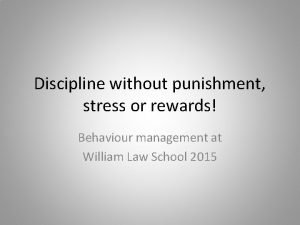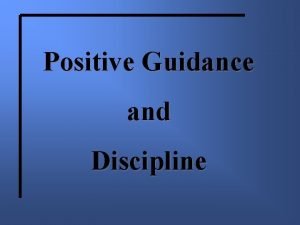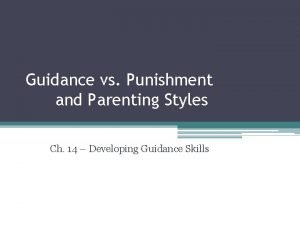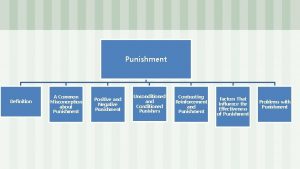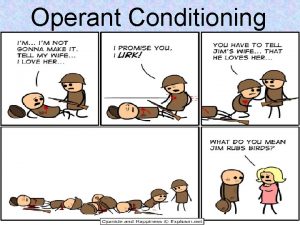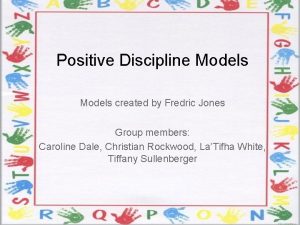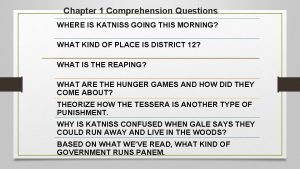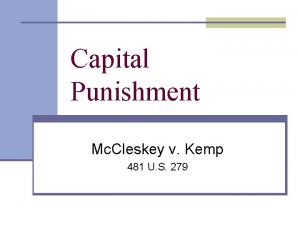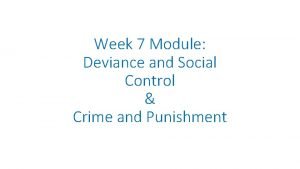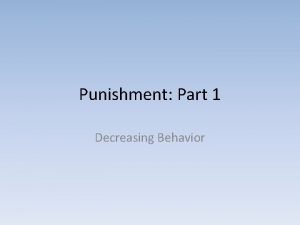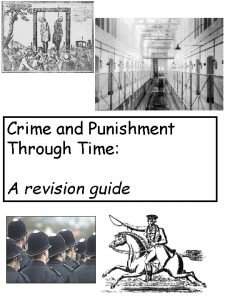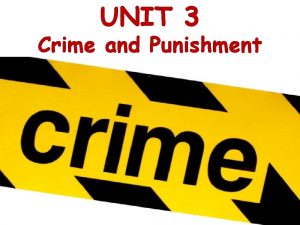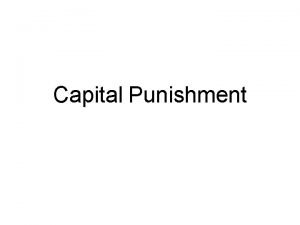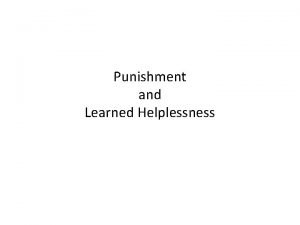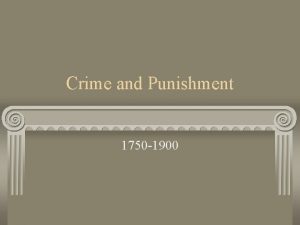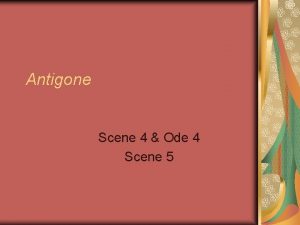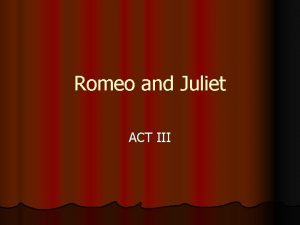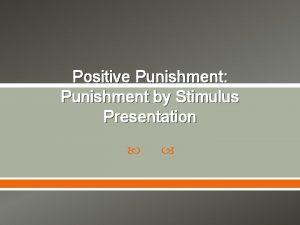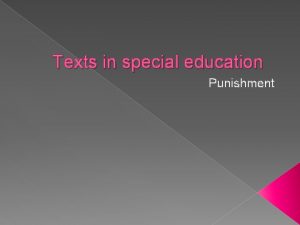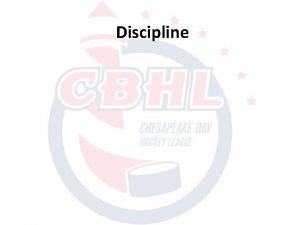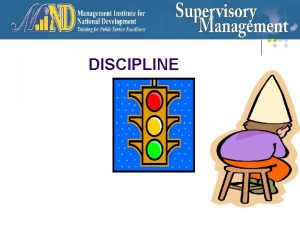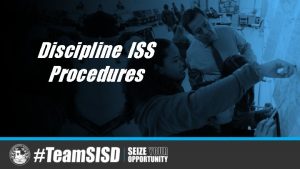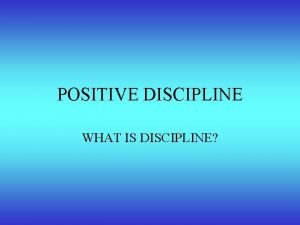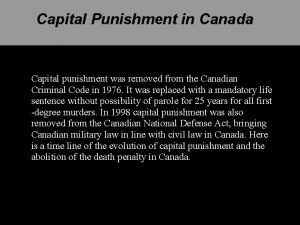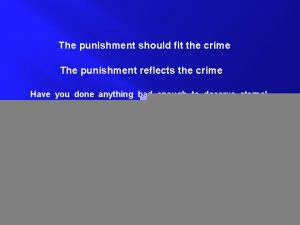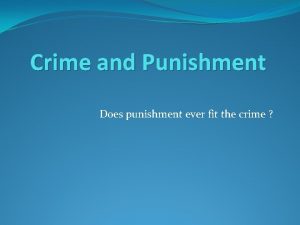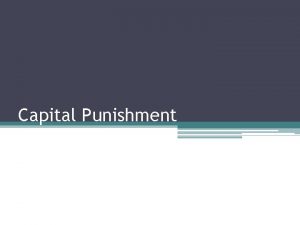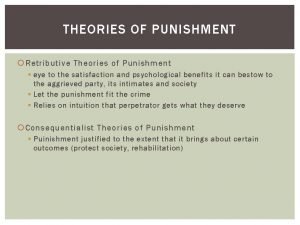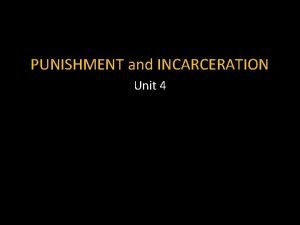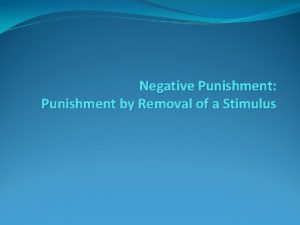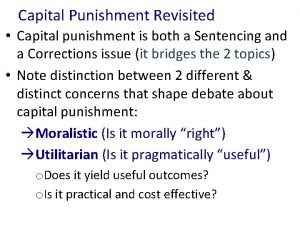Positive Guidance Discipline Punishment Positive Guidance Positive guidance



























- Slides: 27

Positive Guidance & Discipline & Punishment

Positive Guidance Positive guidance is based on the belief that any means of child guidance should focus on building up a child’s self control rather than focusing on a behavioral outcome. It is an understanding that it is not our job as parents/caregivers to eliminate conflict, disappointment, and frustration from the lives of our children, but it is rather to teach our children how to appropriately deal with those situations and emotions. We must also realize that a child’s behavior is not really a reflection on us and our abilities, but a reflection of the child’s choices. Is it our position to help children make better choices by helping them build selfcontrol and social behaviors. Positive guidance focuses more on building the child’s control over self than the adult’s control over the child.

Discipline teaches children self-control. Children learn the benefit of doing what is right. Discipline helps children develop a value system. For example, because of discipline a child speaks and acts honestly. The child knows how to be honest. The child knows why being honest is a correct and wise thing to do.

Punishment controls behavior by using pain or unpleasantness to stop the child who is doing something wrong. Punishment stops bad behavior for the moment. Punishment does not teach the behavior you want. Punishment does not cause good behavior. Punishment stops the unwanted behavior for a short time. Punishment teachers children to avoid being caught. Their behavior is directed toward avoiding punishment.

Posters No Bad Children Only Bad Behavior Hate the Behavior Love the Child

Positive Guidance & Discipline Why do children misbehave?

Reasons for Misbehavior • Stage of Growth: the child is behaving in a normal manner for the stage of growth he/she is in: power, attention, revenge, assumed inadequacy are normal • Unfulfilled Needs: The child’s needs are not being met and she/he is acting out in order to try to get his/her needs met.

Reasons for Misbehavior • Uncomfortable Environment: The child is uncomfortable in or does not understand his/her environment. • Doesn’t know Better: The child has not been taught the concept he/she is dealing with.

Think-Pair-Share • Babysitting/Sibling “Horror Stories”

Positive Guidance Thoughts • Discipline: guidance which helps the child learn self-control • Consistency is the key to guidance • Self-discipline: ability to direct one’s own behavior • Attention is a powerful reinforcer to guide children: they often misbehave for attention • Example: is a very effective • Respond to aggressive behavior in non-aggressive ways way to teach children desired behavior • Children may rebel when parents punish rather than discipline

Types of Guidance Techniques: 1. POSITIVE ROLE MODEL • Children learn from what they see – children are great imitators. *ACTION SPEAKS LOUDER THEN WORDS* Demonstrate the behavior you would like to see in children Model respect, honesty, kindness What type of role model are you? How are you a role model at home and in school?

Types of Guidance Techniques: 2. Natural and Logical Consequences • Natural Consequences: occur without interference, child can see the result of their choices • Cannot be used if the consequence will cause harm to self, others or property, or too far in the future.

Types of Guidance Techniques: 2. Natural and Logical Consequences • Logical Consequences: should be relevant to the misbehavior • To make the punishment fit the crime. • Short in duration, not imposed in anger, provide opportunities for children to learn from their behavior

Applying Natural vs. Logical Natural Consequences Sandy rides her bike into the street after she was told not to. 1. What would be a Natural Consequence? 2. What would be a Logical Consequence? 3. Which should Sandy’s mom choose?

Applying Natural vs. Logical Natural Consequences Despite Dad’s urging him to put on his coat, Tommy goes outside into the cold without wearing a coat. 1. The Natural result for Tommy is? 2. Why is this a natural consequence?

3. Positive Statements • Clearly states what is expected, then help them get started in terms the child understands • When guiding children, phrase all requests in a positive manner – with a verb • Talk to children at their eye level when giving directions: give limited number of directions at a time • Example: say, “Let’s walk to the blocks, ” rather than, “Don’t run to the blocks”

4. Redirection • Children up to two years old can be easily distracted • Get him to focus on something else. • Example: if he is angry at the blocks area, lead him to a different area of the room and introduce a different activity

5. Reverse Attention • When a child’s behavior is inappropriate, focus on a child who is displaying the appropriate behavior and make a positive comment • Ignoring the negative, reinforcing the positive • If the first child changes his behavior, he should be immediately reinforced with a positive statement.

6. Limited Choices • Do not give him an unlimited choice unless he can really have what is chosen. • Only give choices that are available. • Example: “Do you want juice or water for a drink? ” rather than, ‘What would you like to drink? ”

7. Time Out • Use a place where there are no distractions or positive reinforcer • When a child has disobeyed a rule, she will be sent to a predetermined place to distance herself from the problem and gain composure. • Explain to child why they are going into time out: When time is finished, explain to child what your expectations are of them and how you want them to behave the next time • Should be a last option, limited use.

Discipline vs Punishment • Emphasizes what the child should do • Is an ongoing process • Sets an example to follow • Leads to self-control • Helps children change • Is positive • Accepts child’s need to assert self • Fosters child’s ability to think • Bolsters self-esteem • Shapes behavior • Emphasizes what the child should not do • Is a one-time occurrence • Insists on obedience • Undermines independence • Is an adult release • Is negative • Makes children behave • Thinks for the child • Defeats self-esteem • Condemns misbehavior

GROUP What. ACTIVITY might be a possible reason for the child’s behavior & explain how you could use a positive guidance technique: • • • 2 -year- old refuses to get in the bathtub 3 -year-old refuses to leave the park 3 -year-old is throwing food on the floor 5 -year-old does not want to help set the table 6 -year-old wants to splash through deep puddles with their new school shoes • 4 -year old continues to throw toys at another 4 year old.

Each member of group must answer these question in detail in their journals. 1. Why do you think the child is misbehaving? 2. What positive guidance technique(s) are you using? 3. Why are you using this (these) technique (s)? 4. What would be an example of a logical and natural consequence technique to use.

Need to know for Quiz on Positive Guidance 4 Reasons why children misbehave with examples. 4 out of the 6 positive guidance techniques and give examples. Able to tell the difference between a natural and logical consequence Vocabulary words – from Positive Guidance Thoughts and throughout notes /discussions

Behavior Poster On one side – THERE ARE NO BAD CHILDREN ONLY BAD BEHVIOR On other side – HATE THE BEHAVIOR LOVE THE CHILD Create a poster that represents what these statement mean to you.

Index Card HOW ARE YOU GOING TO GET CHILDREN TO LISTEN TO YOU……. . • When I grow up I am going to…… • When I grow up I am not going to……

Positive Guidance • 4 Reasons Children Misbehave (SUUD) • Positive Guidance Techniques (NLPRRLT)
 Discipline without punishment
Discipline without punishment Positive guidance and discipline
Positive guidance and discipline Rigid parenting
Rigid parenting Positive punishment adalah
Positive punishment adalah Operant conditioning types
Operant conditioning types Fredric jones positive classroom discipline
Fredric jones positive classroom discipline Incisal guidance angle
Incisal guidance angle Difference between direct and indirect guidance
Difference between direct and indirect guidance Theorize how the tessera is another type of punishment
Theorize how the tessera is another type of punishment Capital punishment mc
Capital punishment mc What is sexual battery
What is sexual battery Nnn punishments
Nnn punishments Hagans punishment pyramid
Hagans punishment pyramid Sociology chapter 7
Sociology chapter 7 Wjec criminology unit 3
Wjec criminology unit 3 Itnesity
Itnesity Crime and punishment revision guide
Crime and punishment revision guide Crime and punishment key words
Crime and punishment key words Presentation punishment
Presentation punishment Plagiarism crime punishment
Plagiarism crime punishment Chapter 5 to kill a mockingbird
Chapter 5 to kill a mockingbird Edexcel gcse history crime and punishment exam questions
Edexcel gcse history crime and punishment exam questions Capital punishment definition
Capital punishment definition Learned laziness psychology definition
Learned laziness psychology definition Unit 4 criminology wjec
Unit 4 criminology wjec Crime and punishment 1750 to 1900
Crime and punishment 1750 to 1900 Who does antigone blame for her terrible misfortune?
Who does antigone blame for her terrible misfortune? Why did tybalt die
Why did tybalt die
